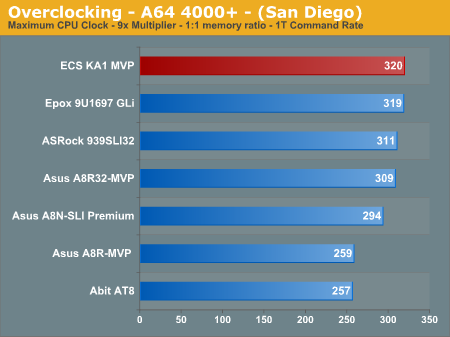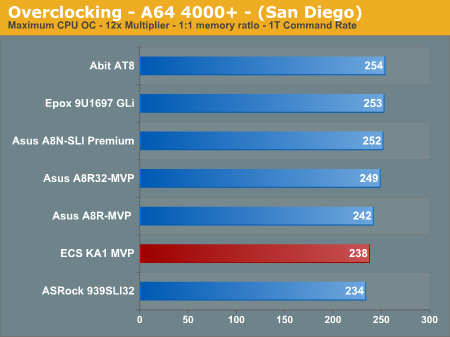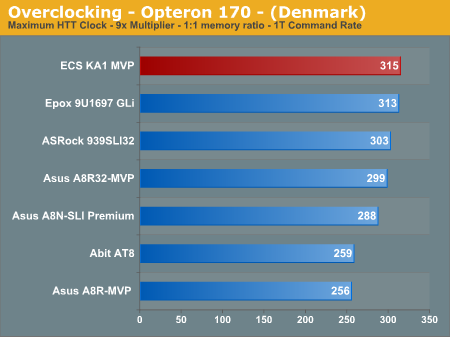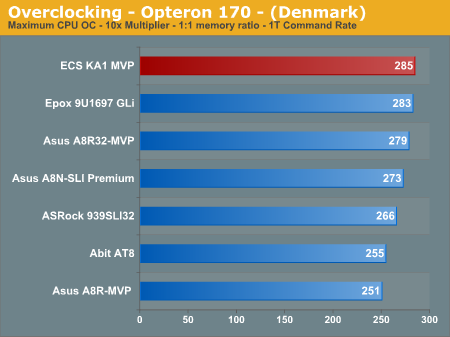Overclocking Performance
The overclocking performance graphs allow for a better comparison on the overclocking capabilities of previously tested boards. For more details on the specific overclocking abilities of this board please refer to the Overclocking and Memory Stress Test section in the Basic Features section.




The ECS KA1 MVP Extreme is an excellent overclocking platform except for the stock 12x multiplier anomaly we witnessed with our AMD Athlon64 4000+ CPU. We had no issues booting into Windows XP at 251HTT x12 settings and running our 3DMark/game benchmarks, but the system was not Prime95/MemTest86 stable for more than six hours unless we dropped to a 238HTT x 12 setting. We tried various voltage settings, LDT multipliers, and memory modules but the system remained unstable in Prime95 and MemTest86 with the 1.1d BIOS. We were able to reach a stable 245HTT x12 setting with the 1.0e BIOS but could not extend the board past 265HTT settings with the original BIOS.
The ability of the ECS KA1 MVP to overclock our Athlon64 4000+ CPU at a 320HTT x9 setting is the best test result we have witnessed with this particular CPU and memory combination. The same holds true for our AMD Opteron 170 CPU with settings of 285HTT x10 and 315HTT x9 while remaining perfectly stable throughout our benchmark testing. We should also note the ability of this board to run our OCZ PC4800 memory at settings of 2.5-3-3-7 at 1T for all overclocking tests.
The overclocking performance graphs allow for a better comparison on the overclocking capabilities of previously tested boards. For more details on the specific overclocking abilities of this board please refer to the Overclocking and Memory Stress Test section in the Basic Features section.




The ECS KA1 MVP Extreme is an excellent overclocking platform except for the stock 12x multiplier anomaly we witnessed with our AMD Athlon64 4000+ CPU. We had no issues booting into Windows XP at 251HTT x12 settings and running our 3DMark/game benchmarks, but the system was not Prime95/MemTest86 stable for more than six hours unless we dropped to a 238HTT x 12 setting. We tried various voltage settings, LDT multipliers, and memory modules but the system remained unstable in Prime95 and MemTest86 with the 1.1d BIOS. We were able to reach a stable 245HTT x12 setting with the 1.0e BIOS but could not extend the board past 265HTT settings with the original BIOS.
The ability of the ECS KA1 MVP to overclock our Athlon64 4000+ CPU at a 320HTT x9 setting is the best test result we have witnessed with this particular CPU and memory combination. The same holds true for our AMD Opteron 170 CPU with settings of 285HTT x10 and 315HTT x9 while remaining perfectly stable throughout our benchmark testing. We should also note the ability of this board to run our OCZ PC4800 memory at settings of 2.5-3-3-7 at 1T for all overclocking tests.










23 Comments
View All Comments
Wesley Fink - Tuesday, April 4, 2006 - link
A video shunt card is the PCB card used in some Crossfire designs for the second x8 slot when you want the other video slot to be x16. When the card is out you have 2 x8 slots, when it's in you have one x16. nVidia uses a similar "paddle" card on their nForce4 SLI design.ATI also has a BIOS switching option on more expensive Crossfire boards. It turned out the simple paddle was the most trouble-free on the Rx480 Crossfire, but most RD580 use the BIOS-switching design and have been trouble-free.
Beenthere - Tuesday, April 4, 2006 - link
SOS, DD.STILL not ready for Prime time but an "E" for effort with an updated BIOS.
Skip the ATI chipset S939 mobos - they are all flops. Hopefully the socket AM2 mobos will be far better than the S939 ATI based crap. ATI must be really disappointed in the Asian mobo makers who refused to deliver a properly operating mobo.
rjm55 - Tuesday, April 4, 2006 - link
Ever since I read about nVidia paying people to post anti-ATI stuff on Forums I've wondered. Do you suppose it's in NV's interest to drum up that the ATI chipset is immature? I only ask cause the same two names always post crap comments about ATI and the A8R-MVP every time a motherboard review goes up at AT.I also bought an A8R-MVP. I was disappointed it required 2T Command Rate above about 260 until I realized the 2T on Asus was just as fast as iT on other boards. At 2T i reached 320. I haven't had a problem other than that and it's the best $95 I ever spent on a board. I liked it so much I bought an A8R32-MVP which I like ever better.
Why don't you jerks that trash these ATI boards tell us SPECIFICALLY what is wrong and provide some evidence so others can take a look at your problems and fix them for you?